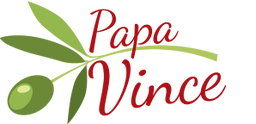Many people ask, 'Is pasta bad for you?' or 'Is spaghetti unhealthy?' The truth is, it depends on the type of pasta and how it's prepared.
With over 100 types of pasta shapes available - from long noodles to penne shaped pasta and stuffed pasta varieties - the options are endless. While many non-enriched pasta brands in USA are becoming available, it's important to understand what sets them apart from conventional enriched options.
Pasta, a universally cherished dish, comes in various types, notably enriched and non-enriched. This blog explores these two forms, exploring their nutritional values and health implications beyond taste.
In "Enriched vs. Non-Enriched Pasta", Unraveling the Differences, we first need to understand food fortification in the U.S.(1), overseen by the FDA. While this organization imposes mandatory guidelines for food enrichment, it does not compel fortification. The practice began in the 1920s to combat nutrient deficiencies, like adding iodine to salt to thwart goiter. By the 1940s, this expanded to include vital nutrients such as thiamin, niacin, riboflavin, and iron in flour. The FDA promotes certain fortification practices through labeling rather than mandates, laying the groundwork for our exploration of pasta types.
Fortification has become essential for mass production to ensure consistent nutritional quality in products, compensating for natural ingredient variations. This method is also cost-effective because adding low-cost vitamins and minerals to processed foods delivers essential nutrients to a broad population at a lower cost compared to altering diets or depending solely on fresh produce.
This blog is more than a comparison; it's an in-depth look at how pasta choices affect your health and culinary experiences. We'll analyze the ingredients, nutritional benefits, and distinctive factors of both wheat pasta types.
Before diving into the comparison, it's important to understand that both enriched and fortified pasta involve adding synthetic nutrients to processed foods. If you're curious about the broader implications of this practice, our comprehensive guide on what is fortified pasta explores the potential health concerns and manufacturing challenges involved in these processes.
By the end, you'll gain insights into the nutritional, taste, and texture differences between Non-Enriched Ancient Grain Durum Wheat Pasta and Enriched Modern Grain Wheat Pasta, enhancing your pasta experience whether you're a connoisseur or a casual eater.
Table of Content
- What Does "Enriched" Mean?
- What Vitamins and Minerals Are Commonly Added to Enriched Pasta?
- Can Enriched Wheat Flour Pasta Help Meet Daily Nutrient Requirements?
- What Are the Potential Drawbacks of Enriched Pasta?
- What Does "Non-Enriched" Mean?
- What Essential Ingredients Define Non-Enriched Pasta?
- Nutritional Value of Non-Enriched Pasta
- Ready to Compare? What Sets Enriched and Non-Enriched Pasta Apart?
- Unveiling the Nutritional Contrast: How Do Enriched and Non-Enriched Pasta Differ?
- Uncovering the Legalities: Manufacturers are Not Required to Label Pasta as 'Enriched
- Does the Cooking Technique Affect the Taste and Texture of Pasta?
- Why Is It So Important to Eat Pasta Al Dente?
- Embark on a Gourmet Journey: Which Non-Enriched Pasta Recipe Will Become Your Favorite?
- Discover Nonna’s Secret to Homemade Fresh Pasta!
- Why Is Papa Vince's Ancient Grain Pasta an Unforgettable Culinary Journey?
BUY NOW & SAVE 10% on your first purchase
Enriched Pasta
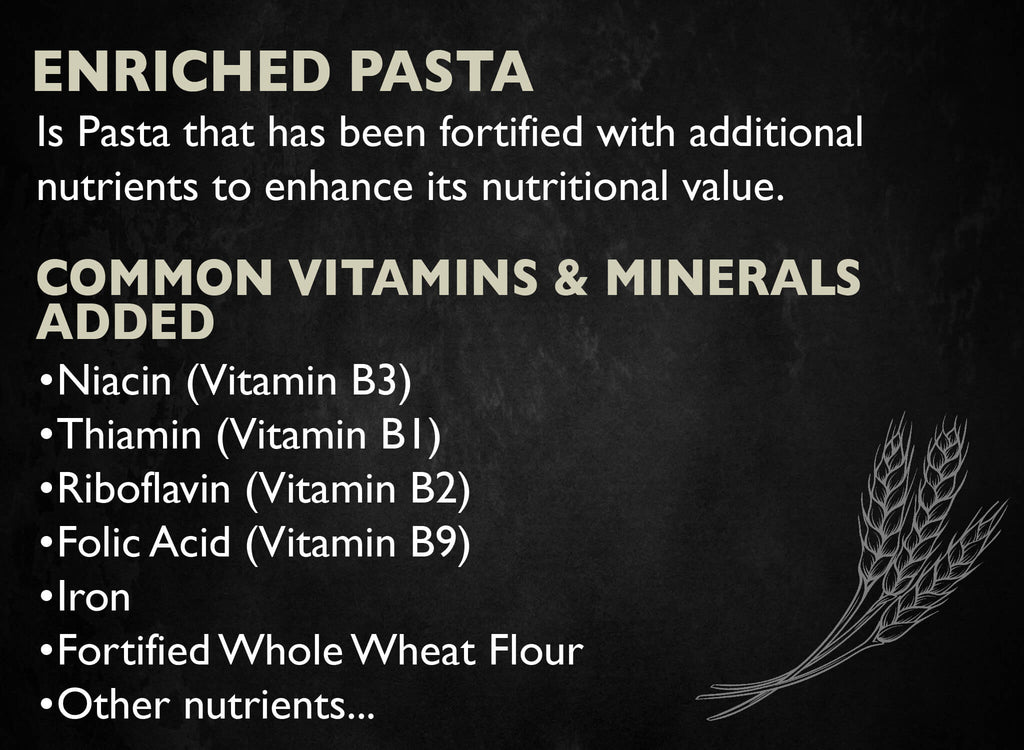
What Does "Enriched" Mean?
Many consumers ask, "What does enriched mean?" when it comes to pasta products. The answer lies in understanding both what's lost and what's added back during processing.
A key consideration is "Does pasta contain lipids?" The answer is complex and depends on how the pasta is processed. In traditional stone-ground wheat, lipids are naturally present in the wheat germ, which contains healthy fats, antioxidants, and vitamin E. However, modern industrial processing methods remove the germ and bran layers to create refined white flour, eliminating these beneficial lipids along with other nutrients.
This is where the difference in processing methods becomes crucial:
- Stone Grinding (Traditional Method):
- Preserves all three parts of the wheat kernel intact:
- Bran (outer layer with fiber)
- Germ (nutrient-rich core with healthy lipids)
- Endosperm (starchy interior)
- Maintains natural oils and nutrients
- Creates a more nutritionally complete pasta
- Preserves all three parts of the wheat kernel intact:
- Industrial Refining (Modern Method):
- Removes the germ and bran
- Strips away natural lipids
- Eliminates vitamins and minerals
- Results in white flour that requires enrichment
This is why enrichment became necessary—to add back some (but not all) of the nutrients lost during industrial processing. Enriched pasta has specific vitamins and minerals added back in synthetic form, though it can't fully replicate the complex nutritional profile of traditional stone-ground wheat pasta, particularly when it comes to the natural lipids and their associated benefits.
Enriched pasta refers to pasta that has been fortified with additional nutrients to enhance its nutritional value. The term "enriched" indicates that specific vitamins and minerals have been added to the pasta to replenish or augment the nutrients lost during the grain refining and pasta-making processes. This process is similar to how manufacturers enrich supplements to boost their nutritional content.
Many health-conscious consumers today are seeking alternatives like breads without folic acid and organic non-fortified, non-enriched pasta as they become more aware of the differences between natural and synthetic nutrients. While some may search for "semolina flour near me" to make their own pasta, understanding the broader implications of flour choices is crucial.
What Vitamins and Minerals Are Commonly Added to Enriched Pasta?
-
Niacin (Vitamin B3): A water-soluble vitamin that helps convert food into energy, supports proper digestion, and contributes to maintaining healthy skin, nerves, and blood cells.
-
Iron: An essential mineral that plays a vital role in transporting oxygen throughout the body, promoting the production of red blood cells, and supporting overall energy levels.
-
Thiamin (Vitamin B1): Crucial for converting carbohydrates into energy and helps maintain a healthy nervous system. It also supports proper muscle and heart function.
-
Riboflavin (Vitamin B2): Involved in energy metabolism, helps maintain healthy skin and eyes, and supports the growth and repair of tissues.
-
Folic Acid (Manufactured Vitamin B9): This synthetic folic acid is added during manufacturing and differs from natural folate found in whole foods. While it's meant to prevent neural tube defects in developing fetuses, some researchers suggest that natural sources might be more beneficial than synthetic ones.
The FDA states(2), “Folate is naturally present in many foods, including vegetables, fruits and fruit juices, beef liver, nuts, and beans and peas.
You also get folate by eating foods fortified with folic acid. Folic acid is a form of folate that can be added to foods during the manufacturing process.”
-
Fortified Whole Wheat Flour: Enriched whole wheat pasta may be made with fortified whole wheat flour, which retains the bran and germ layers, providing additional fiber, vitamins, and minerals compared to refined wheat flour.
-
Other Nutrients: Depending on the brand or specific formulation, enriched pasta might include additional nutrients such as vitamin D, calcium, or other essential vitamins and minerals.
Enriched Pasta is a convenient way to incorporate important nutrients into meals, especially for individuals with dietary restrictions or limited access to other food sources rich in these vitamins and minerals.
Can Enriched Wheat Flour Pasta Help Meet Daily Nutrient Requirements?
Maybe. Especially for those with limited access to a variety of nutrient-dense foods or who have dietary restrictions, incorporating enriched Pasta into one's diet can be beneficial in fulfilling daily nutrient needs. However, it's important to note that not all pasta contains egg, and the nutritional profile can vary between egg pasta and non-egg pasta varieties.
What Are the Potential Drawbacks of Enriched Pasta?
Worries Regarding Additives and Processing Methods
While the added nutrients in enriched Pasta can be beneficial, natural sources of vitamins and minerals are usually better than enriched ones. If you prefer a more natural approach to nutrient intake, opt for non-enriched Wheat Pasta and incorporate a variety of whole food nutrition into your diet.
Additionally, some individuals may have specific dietary restrictions or sensitivities to certain additives used in the enrichment process. It is essential to read ingredient labels and be aware of any potential allergens or additives that may be present in the enriched Pasta.
Chickpea pasta has gained popularity as a gluten free pasta alternative, high in protein. However, recent studies have shown that some chickpea pastas test high for glyphosate residues, making them potentially less healthy than advertised. It's crucial to research and choose your alternative pastas carefully.
Impact of Enrichment on Taste and Texture
Adding nutrients and other ingredients during the production of enriched Pasta can slightly alter its taste and texture compared to traditional Pasta. The fortified ingredients may impart a slightly different flavor profile or affect the texture to some degree.
However, taste preferences can vary significantly from person to person. Some may not notice or mind the slight variations. In contrast, others may have a distinct choice for the taste and texture of non-enriched Pasta.
Also, many manufacturers strive to create enriched Pasta that closely resembles the taste and texture of non-enriched alternatives.
Folate is found in Mother’s Milk, not Folic Acid!
– Says Dr. Jin Sung in his video "Vitamin B9—Folate vs Folic Acid."(3)
Dr. Sung, a Chiropractic Physician in Massachusetts, specializes in treating complex chronic conditions using natural and alternative therapies. His expertise extends to conditions like Hashimoto's, IBS, and early Alzheimer's. In his video he addressed the differences between folic acid and folate.
Folate is the natural form of Vitamin B9 and is more complex in structure, containing several glutamate residues. It is in a reduced form, making it readily absorbable by the body. You can find folate in natural sources such as leafy greens, legumes, and liver. Notably, folate is converted to its active form more efficiently in the gut, making it the preferred form for overall health and potentially lowering the risk of cancer.
In contrast, Folic Acid is the synthetic form of Vitamin B9. It is simpler in composition, having only one glutamate residue, and is fully oxidized, which lends it stability to heat and light. Folic Acid is commonly added to fortified foods and supplements. While it is absorbed efficiently, it takes longer to convert to its active form in the body. There is a concern that a build-up of Folic Acid in the system might increase the risk of cancer, though this requires further research.
The symptoms of folate deficiency can affect the heart, brain, mental health, and blood health. For mothers , especially those who are breastfeeding, prioritizing folate-rich foods is recommended because Folate is found in Mother’s Milk.
In general, the recommendation for most people is to aim for folate from natural sources whenever possible. If using folic acid supplements, it's important to monitor the total intake to avoid an excess that could lead to health complications.
BUY NOW & SAVE 10% on your first purchase
Non-enriched Pasta
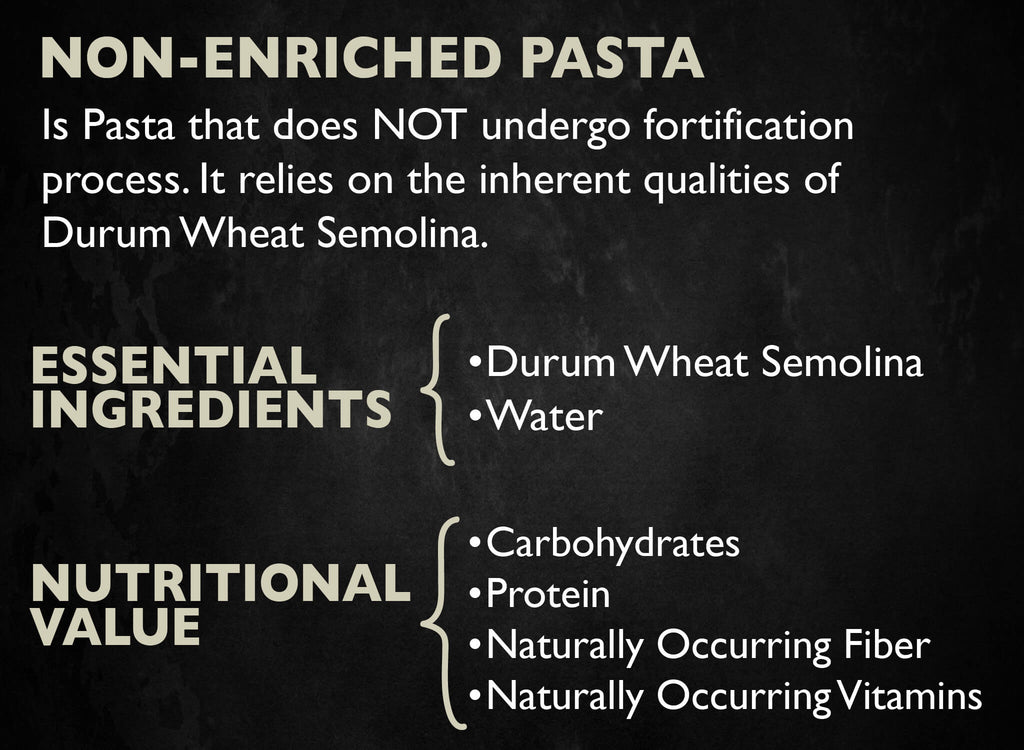
What does "Non-Enriched" mean?
Non-enriched pasta refers to pasta that does not undergo an enrichment process to add specific nutrients. It relies on the inherent qualities of traditional artisanal pasta-making techniques to deliver naturally occurring nutrition, distinctive taste, texture, and cooking characteristics. Non-enriched pasta—especially those made from ancient grains—can be part of a healthy diet. Unlike refined grains, these pastas retain more of their natural nutrients and fiber.
What Essential Ingredients Define Non-Enriched Pasta?
Non-enriched pasta is made using essential ingredients.
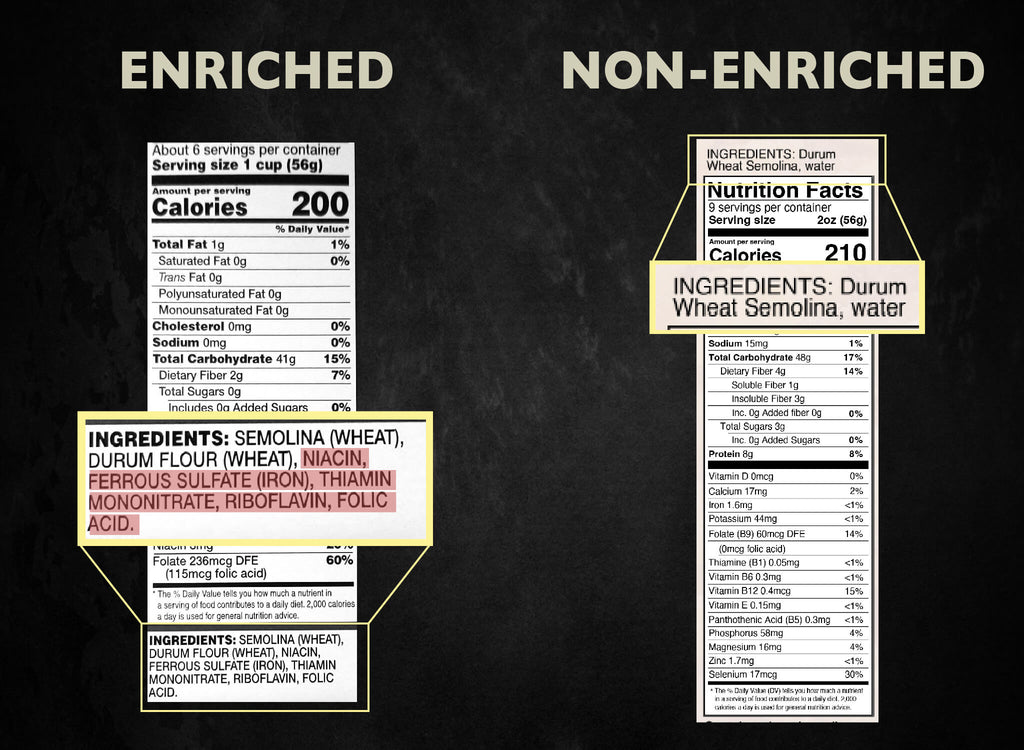
-
Durum Wheat Semolina: The primary ingredient in non-enriched pasta is durum wheat semolina, a coarse wheat flour derived from durum wheat. This high-protein flour gives pasta its golden color and contributes to its firm texture when cooked.
-
Water: Used to form the pasta dough. The amount of water influences the texture and consistency of the pasta.
It's worth noting that while some pasta varieties, such as fresh egg pasta, contain eggs, many types of dried pasta are made without eggs. The presence of eggs can affect the taste, texture, and nutritional profile of the pasta.
Nutritional Value of Non-Enriched Pasta
Non-enriched Pasta offers a range of intrinsic nutrients derived from its main ingredient, durum wheat semolina. While it may not have the added vitamins and minerals in enriched wheat Pasta, it still provides several essential natural nutrients.
When considering pasta nutrition, many wonder " does pasta contain fibre ?" Yes, especially non-enriched whole grain pasta, which can be an excellent source of dietary fiber. Pasta enables better digestion through its fiber content, particularly when cooked properly. But there's way more than just fiber!
Carbohydrates
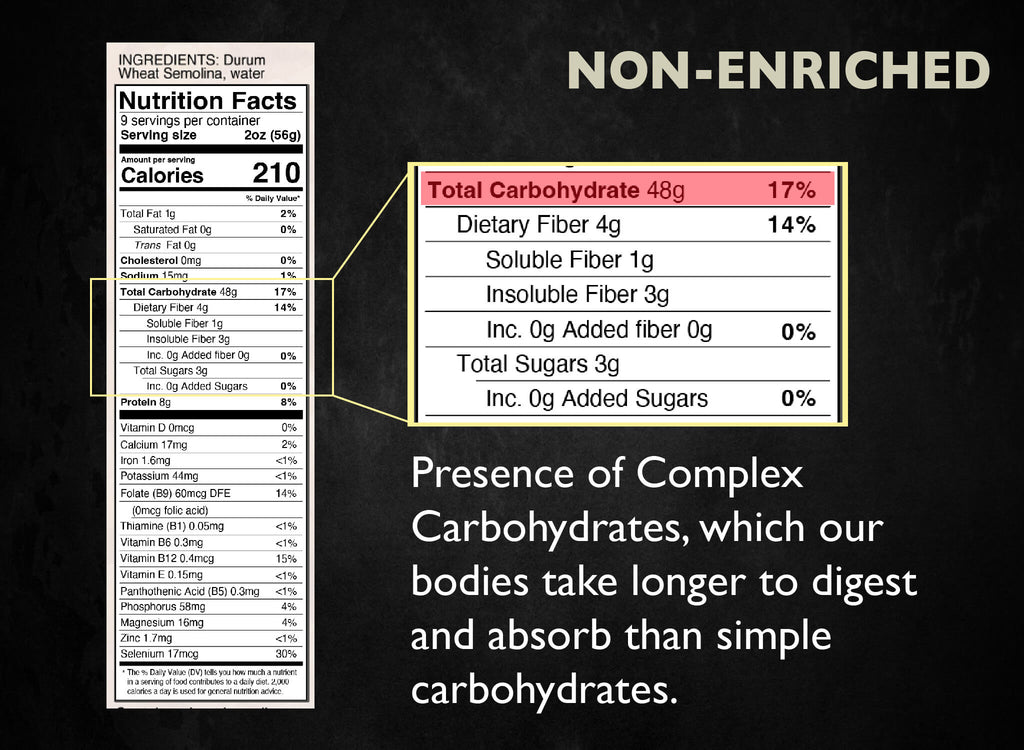
Ancient grains are higher in fiber than modern wheat, promoting gut health and slowing sugar absorption. One of the key benefits of ancient grains is their higher content of complex carbohydrates compared to modern wheat varieties.
So, non-enriched Pasta is a rich source of complex carbohydrates, the body's primary energy source. These carbohydrates provide fuel for physical activities and support overall bodily functions.
Complex carbohydrates, also known as polysaccharides, are a carbohydrate that our bodies take longer to digest and absorb than simple carbohydrates.
They also contain resistant starch, which feeds beneficial gut bacteria, and have a more rigid outer shell that slows down carbohydrate breakdown for sustained energy.
Many wonder, “Does whole wheat pasta have carbs?” Yes, it does. However, whole wheat pastas contain complex carbohydrates and fiber, which are processed differently by your body compared to simple carbs in white pasta.
Another common question is, “Is pasta easy to digest?” The answer varies. Traditional pasta shapes like tagliatelle, with their thicker form, can actually be easier on your digestive system. Their shape and texture result in a lower glycemic index, meaning they're digested more slowly, providing sustained energy without rapid blood sugar spikes.
When considering “Is white pasta good for you?” remember that while it's not inherently bad, it lacks the fiber and nutrients found in whole grain options. Some brands offer white fiber pasta, attempting to bridge this gap, but it's really just a "Frankenstein" creation since they are adding reconstructed bran back to the flour to be able to classify it as "whole grain."
Stone-milled ancient grains are truly whole grain, preserving all three parts of the original wheat kernel intact: endosperm, bran, and germ.
Fiber

Non-enriched Pasta, mainly whole wheat varieties, can be a good source of dietary fiber. Fiber aids digestion, promotes satiety and helps maintain healthy cholesterol and blood sugar levels.
Pasta, particularly varieties high in dietary fiber, offers significant health benefits due to its carbohydrate composition. The carbohydrates in high-fiber pasta are complex carbohydrates, meaning they break down slowly during digestion.
This slow breakdown process is essential for maintaining steady blood sugar levels, leading to a more gradual and controlled release of glucose into the bloodstream. This starkly contrasts simple sugars, which are absorbed rapidly and can cause sudden spikes in blood sugar.
Soluble fiber, present in specific pasta types, creates a gel-like substance in the digestive tract, slowing digestion and moderating carbohydrate and sugar absorption. This results in steady nutrient uptake, aiding in stabilizing blood sugar levels.
Additionally, the inclusion of insoluble fiber, often reduced during refining, bulks up stools and promotes regular bowel movements, thereby preventing constipation. This combination of soluble and insoluble fiber offers a comprehensive digestive benefit, balancing blood sugar while ensuring digestive regularity.
Protein

Durum wheat semolina provides a moderate protein content. Protein is essential for tissue repair, muscle development, and numerous biochemical processes.
Also, when paired with dietary and soluble fibers, enhances overall health by creating prolonged satiety, stabilizing blood sugar levels, and supporting gut health. This synergistic combination also helps lower cholesterol levels and promotes muscle growth and recovery, making it a vital component of a balanced diet.
B Vitamins
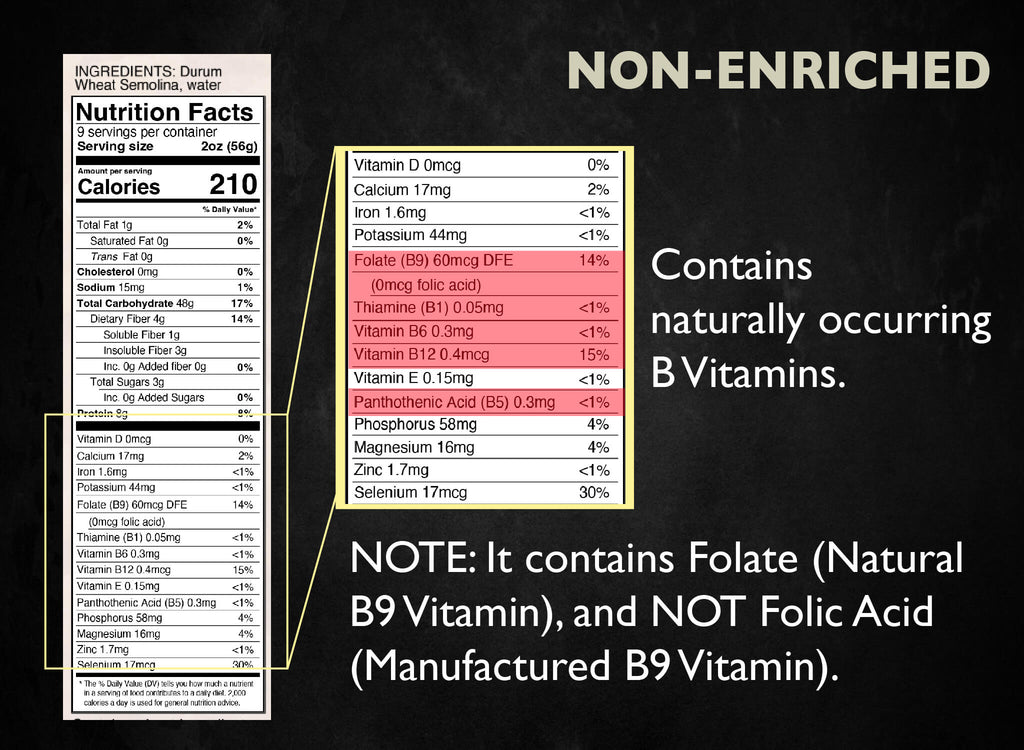
Non-enriched Pasta contains natural B vitamins, including thiamin (B1), riboflavin (B2), niacin (B3), and folate (B9). These vitamins are important in energy metabolism, nervous system function, and overall cellular health.
Moreover, B vitamins are integral for maintaining overall cellular health, assisting in the formation of red blood cells and cellular repair.
Interestingly, traditional wheat pasta, particularly those made from durum wheat semolina, stands out as a rare food source that naturally contains Vitamin B9 (folate). This is noteworthy because most pasta brands opt for enriched wheat pasta varieties, where vitamins are added back into the product after processing. This enrichment process is intended to compensate for nutrient loss during manufacturing!
However, natural sources of these vitamins, as found in non-enriched pasta, are often more beneficial as they are in a form that the body can absorb and use more efficiently. These naturally occurring B vitamins in non-enriched traditional pasta make it a valuable addition to a balanced diet, offering a wholesome alternative to enriched products.
Ready to Compare? What Sets Enriched and Non-Enriched Pasta Apart?
Unveiling the Nutritional Contrast: How Do Enriched and Non-Enriched Pasta Differ?
There are notable differences in nutrient content when comparing enriched and non-enriched pastas.
Enriched pasta contains added vitamins and minerals, such as Iron, folic acid, and B vitamins, which are not naturally present in significant amounts in non-enriched Pasta.

Nature skillfully combines a variety of vitamins, minerals, and other beneficial compounds in food. These elements work together in a way that enhances their absorption and effectiveness. For example, vitamin C helps in the absorption of iron, and B vitamins work together to energize our cells. However, when we depend mostly on enriched foods, we miss out on this natural harmony. Enriched foods often contain just a few added nutrients, which might prevent deficiencies but don’t offer the full range of benefits that come from the natural combination of nutrients in whole foods.
On the other hand, non-enriched Pasta offers inherent nutrients from the durum wheat semolina used in its production, including carbohydrates, protein, fiber, and natural B vitamins.
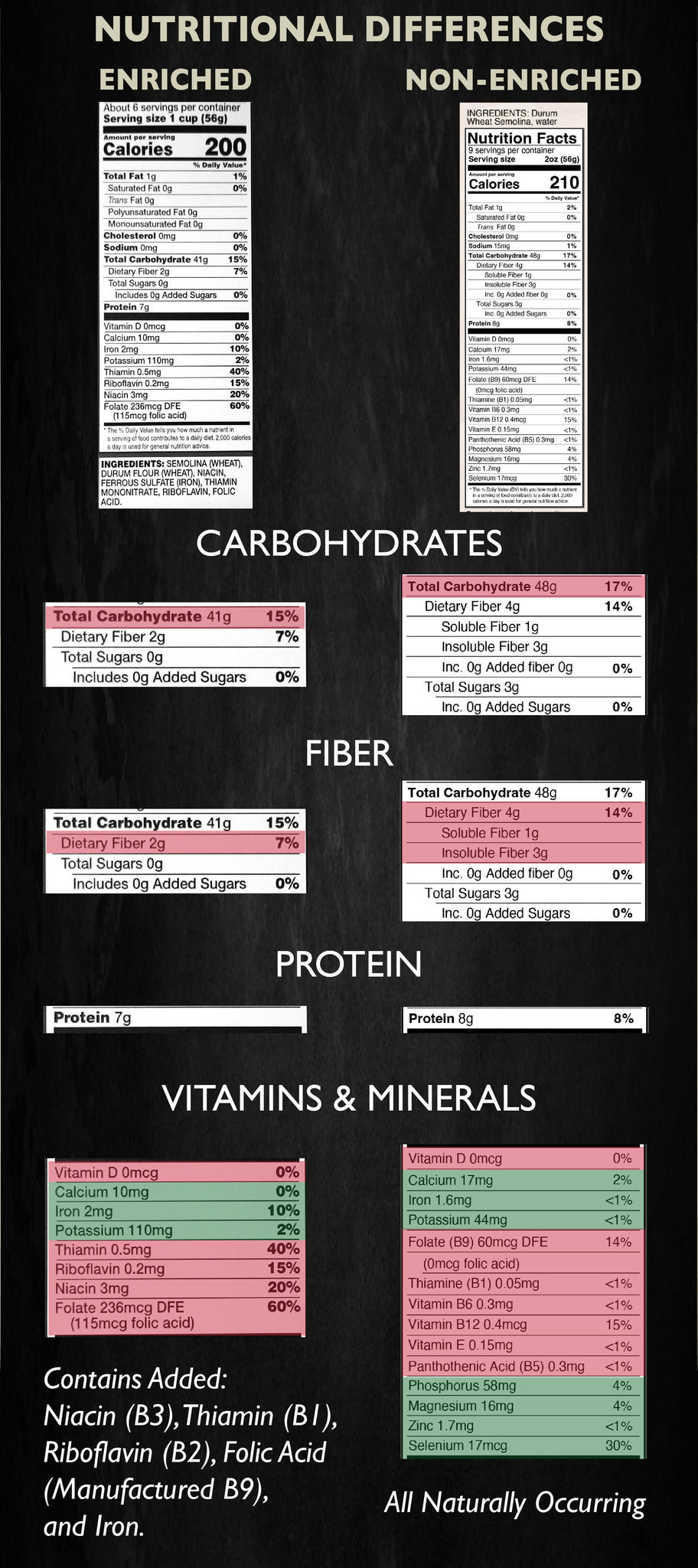
Non-enriched foods display their naturally occurring nutrient content on their nutritional labels, but this might not always align with the recommended Daily Values. Take whole-wheat bread as an example: it's rich in fiber and B vitamins, but it might lack sufficient amounts of minerals like iron or folate.
On the other hand, enriched foods have added manufactured vitamins and minerals to boost their nutritional value , often meeting or surpassing the Daily Value recommendations. A good example is fortified breakfast cereals. Naturally, they don't contain Vitamin D, but when enriched with it, they can offer a substantial portion of its Daily Value.
So, when selecting between non-enriched and enriched Pasta, you must consider your overall dietary needs, preferences, and other nutrient sources. If you seek vitamins and nutrients from natural sources, opt for Non-Enriched Pasta.
Uncovering the Legalities: Manufacturers are Not Required to Label Pasta as 'Enriched'
Legally, manufacturers of enriched pasta in the US are required to list the enrichment ingredients (e.g., folic acid, iron, B vitamins) in the ingredients section, but they are not obligated to state "enriched" on the label explicitly. This practice complies with the Food and Drug Administration (FDA) regulations for labeling enriched grain products.
The term "non-enriched" is not a standardized label in the food industry, meaning the FDA does not regulate it. Therefore, it's unlikely to find products explicitly labeled as "non-enriched." However, if a wheat pasta product is not enriched, it typically won't list added vitamins and minerals in the ingredients. This is a good indicator of non-enrichment but not definitive.
The FDA requires enriched grain products to meet specific nutritional standards, including minimum levels of iron, thiamine, riboflavin, niacin, and folic acid. Manufacturers can add enrichment ingredients beyond those required by the FDA.
You might ask, 'Is enriched flour bad for you?' While enriched flour adds back some nutrients lost in processing, it's not the same as whole grain flour. Opting for non-enriched, whole grain pasta can provide more natural nutrients and fiber.
So, to determine whether wheat pasta is enriched or non-enriched, simply review the ingredient list. Ask yourself: Are there any enrichment additives included (iron, folic acid, niacin, etc.) or is the first ingredient "enriched flour" (wheat flour, niacin, reduced iron, vitamin B2, folic acid)?
If the answer is yes, then the pasta is enriched; if not, it is non-enriched wheat pasta. (4)
It's also important to check if the pasta contains eggs, as this can significantly affect its nutritional profile. (5)
How Do Production Methods Vary Between Enriched and Non-Enriched Pasta?
Ingredient Selection
Ancient Grain non-enriched Pasta primarily relies on durum wheat semolina as its main ingredient. In contrast, enriched Pasta incorporates additional nutrients and fortified ingredients.
Nutritional Aspects
Non-enriched Pasta naturally contains fewer vitamins and minerals than enriched Pasta. Its nutritional value is primarily derived from the durum wheat semolina, which offers protein, fiber, and some essential nutrients.
The process of refining wheat removes a wealth of nutrients, as much as 30-40 different types, including fiber, B vitamins (such as B4, B5, B1, B12, B9), vitamin E, and minerals like magnesium, phosphorus, zinc, selenium, manganese, and iron. These nutrients are retained when wheat is not refined and through traditional pasta-making methods, which involve slower processing and lower temperatures.
Processing
Non-enriched Pasta production is based on the traditional process of mixing durum wheat semolina and water to form a dough. This dough is then rolled out, shaped, and dried. The processing methods focus on preserving the natural characteristics of the durum wheat semolina:
- Preserving Ancient Whole Grains: We preserve the integrity of ancient grains, ensuring they remain as genetically pure as before WWII.
- Stone-Grinding for Nutrition: We retain the whole wheat's original parts and total nutritional value by stone-grinding at low speeds and temperatures.
- Eliminating the Need for Enrichment: Our process ensures no nutritional value is lost, making artificial enrichment unnecessary.
- Slow Drying for Digestibility: We slow-dry our pasta dough to keep the gluten composition unchanged, making it easier for your digestion.
- Enhancing with Bronze Die Cutting: Our bronze die-cut technique roughens the pasta's surface, allowing sauces to cling better and elevate your dining experience.
On the other hand, Enriched Pasta production is made by an industrial process, which focuses on making enriched pasta to produce a nutrient-dense, consistent, and cost-effective product. This involves several key objectives:
- Selecting Grains: Manufacturers select durum wheat for pasta making, chosen for its high protein and strong gluten content.
- Milling and Refining: Steel rollers mill the grains, effectively removing the bran and germ from the wheat kernel and leaving behind mostly the endosperm. This step causes a significant loss of natural nutrients and fiber.
- Enriching Flour: Post-milling, the flour undergoes enrichment to replenish lost nutrients. This involves adding back essential elements like iron and B vitamins, including folic acid, riboflavin, niacin, and thiamine.
- Dough Preparation: Workers mix the enriched flour with water, and sometimes eggs, to create the pasta dough. They then knead this dough thoroughly to develop the gluten, a key component for the desired pasta texture.
- Forming Pasta Shapes: The prepared dough is then molded into various pasta shapes. This shaping process might involve extruding.
- Rapid Drying: Finally, the pasta undergoes a rapid drying process at high temperatures. While this method is efficient for mass production, it has the downside of potentially destroying some of the vitamins added during enrichment.
Taste and Texture
Non-enriched Traditional Pasta often has a more pronounced wheat flavor than enriched Pasta. It tends to have a firm and chewy texture, especially when cooked al dente. The absence of added ingredients allows the natural qualities of the durum wheat semolina to shine, resulting in a more authentic pasta experience.
Enriched pasta is generally smoother due to the use of refined flour, which lacks the bran and germ present in whole wheat. This refining process results in a finer, less coarse flour, contributing to a smoother texture and stronger gluten network in the pasta. Also, it lacks the grainy texture of whole wheat pasta and has a more neutral, mild flavor.
The difference in taste and texture is primarily due to the refining and milling process rather than the enrichment process itself.
The fewer ingredients, the better
Non-enriched Pasta offers a purer expression of the core ingredients and their natural attributes. Its simplicity can appeal to those who prefer a more traditional pasta taste and texture or those seeking a minimalist diet.
Does the Cooking Technique Affect the Taste and Texture of Pasta?
Yes! The cooking time and method can also influence the taste and texture of whole grain Pasta. Both enriched and non-enriched Pasta can be cooked to different levels of doneness, allowing for variations in texture and mouthfeel. Experimenting with cooking times and techniques can help you achieve the desired texture and consistency for your fresh pasta dishes.
Traditional pasta shapes have different optimal cooking times. For example:
- Long pasta like spaghetti: 8–12 minutes
- Penne shaped pasta: 10–13 minutes
- Stuffed pasta like ravioli: 4–9 minutes, depending on size
- Short pasta for pasta salads: 8–10 minutes
The cooking technique can significantly affect pasta's texture and digestibility. Understanding the difference between al dente vs tender pasta is crucial - al dente pasta has a firmer bite and lower glycemic impact, while tender pasta breaks down more quickly in your system. This is especially important when making pasta salads , where maintaining the right texture is essential for both taste and nutrition.
The cooking process significantly impacts pasta's texture and nutritional value. Starting with uncooked pasta , bring water to a moderate boil before adding your pasta - whether it's spaghetti, penne, or fusilli (spiral-shaped pasta that excellently holds sauce in its grooves). Many modern pots come with a built in strainer in the lid, making drainage easier and safer.
Why is it So Important to Eat Pasta AL-DENTE?
A recent study(5) highlighted the impact of cooking time on starch digestion in wheat pasta. When pasta is undercooked, less starch is digested—meaning the body breaks it down more slowly than pasta cooked just right. Conversely, overcooked pasta results in greater starch digestion, as its starches are broken down more quickly. The study noted that reducing cooking time to achieve a traditional Italian al dente texture—especially with high-protein pasta—can help slow the rate of starch digestion.

Starch digestion refers to the process by which the body breaks down starch, a type of carbohydrate found in foods like wheat pasta, into simpler sugars. This digestion begins in the mouth with saliva and continues in the intestines. The rate of starch digestion influences how quickly these sugars are released into the bloodstream, affecting blood sugar levels. Thus, how pasta is cooked can significantly impact its starch digestion rate and consequently, the body's blood sugar response.
Another common question is “Does pasta make you bloated?” The answer often depends on several factors, including the type of pasta, cooking method, and individual sensitivities to wheat gluten. Traditional, properly cooked pasta made with high-quality ingredients like organic wheat flour or bread flour typically causes less digestive discomfort than heavily processed alternatives.
Embark on a gourmet journey. Which non-enriched pasta recipe will become your favorite?
Pasta All’Arrabiata
Pasta all'Arrabbiata is an Italian dish with a delicious flavor that can be prepared in just 30 minutes. It uses classic Italian ingredients like spaghetti or fresh pasta, tomato sauce, fresh basil, parmesan cheese, and extra virgin olive oil.
3-Ingredient Pasta: Cacio e Pepe
Cacio e Pepe is a testament to the ingenuity and resourcefulness of the shepherds who roamed the Lazio countryside. This classic Italian pasta dish, which translates to "cheese and pepper," embodies the essence of Roman cuisine with its minimalistic yet powerful combination of ingredients: cheese, pepper, and extra virgin olive oil.
Balsamic Chicken Busiate
Balsamic Chicken Busiate is one of those recipes where the sauce reigns supreme. This particular dish creates a delightful symphony of flavors by combining the richness of balsamic vinegar, the creaminess of heavy cream, and the depth of chicken broth. A touch of sweetness, a hint of tanginess, and an overall lusciousness define this creamy sauce, making it an absolute sensation for the taste buds.
Discover Nonna’s Secret to Homemade Fresh Pasta!
In the heart of Italian culture, the art of making homemade fresh pasta embodies a deep-seated love for food, tradition, and quality. It stands as a living testament to Italy's rich culinary identity, weaving together the threads of heritage and creativity.
In this vibrant tapestry of culinary tradition, "nonnas" - the affectionate term for grandmothers - play a pivotal role.
Picture a cozy Italian kitchen where a nonna, with her skilled hands and years of wisdom, guides her grandchildren through the delicate process of kneading dough. Nonna’s stories and techniques pass down through generations, and it’s not just about making fresh pasta; it’s about lessons in life, love, and the importance of preserving cultural roots.
Bathed in the rich legacy of Italian culinary traditions, let's step into Nonna's kitchen, where the simple yet profound art of making homemade fresh pasta comes to life.
Ingredients:
- 2 cups flour
- 2 eggs
- 1 tsp Papa Vince Extra Virgin Olive Oil (EVOO)
- Papa Vince Sea Salt
- Papa Vince Tomato Sauce (to serve)
- Fresh basil and fresh Parmesan (to serve)
How to make:
- On a wooden surface, form a well in the flour. Add 2 eggs, 1 tsp of Papa Vince Extra Virgin Olive Oil, and a pinch of salt. Mix with a fork, then knead with your hands to form a dough.
- Knead the dough for 3–4 minutes, adding a little water if needed to bring it together.
- Wrap the dough in plastic wrap and refrigerate for at least 30 minutes, or overnight if preparing in advance.
- Cut a portion of the dough and roll it through a pasta machine—start at the widest setting and gradually reduce to settings 2 or 3, dusting with flour as needed to prevent sticking.
- Boil the pasta for 2 minutes, then serve with Papa Vince Tomato Sauce, fresh Parmesan, basil, and a splash of Papa Vince Extra Virgin Olive Oil.
Why is Papa Vince's Ancient Grain Pasta an Unforgettable Culinary Journey?
One wheat pasta variety that stands out in non-enriched pasta is Papa Vince Ancient Grain Pasta. Made from ancient grains, Durum and Tumminia, grown in Sicily, Italy, offer a distinct set of qualities that set them apart from traditional wheat pasta.
Papa Vince Whole Wheat Pasta prides itself on being non-enriched, meaning it does not undergo fortification or the addition of specific nutrients.
Why is it Unique?
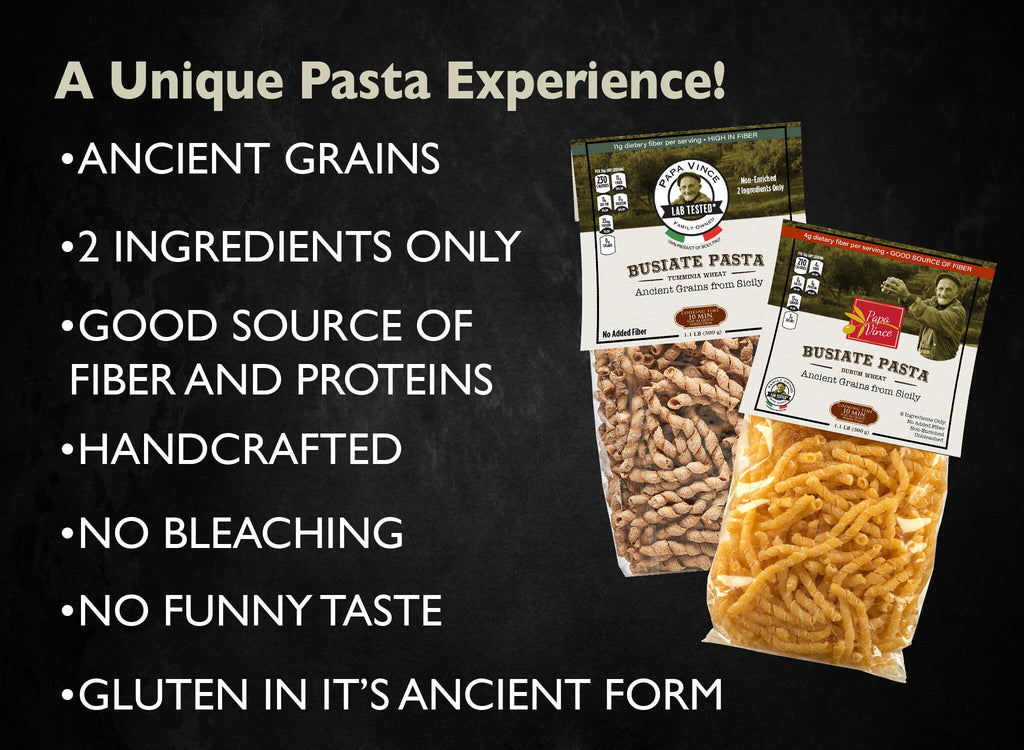
ANCIENT GRAINS - Papa Vince Whole Wheat Pasta is crafted using ancient grains sourced from Sicily, Italy. These grains are known for their rich heritage and nutritional benefits, offering a unique taste and texture profile.
2 INGREDIENTS ONLY - Made using Durum and Tumminia Wheat Semolina, respectively, and Water. Papa Vince Pastas do not contain eggs.
GOOD SOURCE OF FIBER AND PROTEINS - Ancient grains are a complete source of naturally occurring proteins & prebiotic fiber (soluble & insoluble), supporting anti-inflammatory diets.
HANDCRAFTED BUSIATE - The Pasta is handcrafted using traditional methods; specifically, it takes the corkscrew shape. Busiate pasta, known for its spiral shape, is crafted using a bronze die cut. This technique imparts a coarse texture to the pasta, allowing it to capture sauce effectively. This not only enhances the flavor but also elevates the overall dining experience.
NO BLEACHING - Papa Vince Whole Wheat Pasta does not undergo bleaching, ensuring the Pasta retains its natural color and integrity. This absence of bleaching agents preserves the Pasta's nutritional value and authentic appearance.
Learn more about: Bleached vs. Non-Bleached Pasta: Unraveling the Differences
NO FUNNY TASTE - One common concern with some non-enriched pasta varieties is the presence of a distinct taste that may appeal to some. Papa Vince Whole Wheat Pasta addresses this concern by ensuring pasta free from any "funny" taste, allowing the natural flavors of the Durum and Tumminia wheat to shine through.
GLUTEN IN ITS ANCIENT FORM - Ancient Grains have remained unaltered by modern intensive breeding techniques. Papa Vince Pasta is crafted from the very grains consumed by the valiant Ancient Roman Legionnaires.
Understanding the nutritional significance of noodles and pasta goes beyond just their carbohydrate content. These staple foods can be excellent sources of sustained energy, particularly when made with whole grain flours and traditional processing methods.
A Traditional Wheat Pasta Experience
Papa Vince Ancient Grain Pasta presents a distinctive pasta experience that combines the richness of ancient grains, traditional craftsmanship, and a commitment to preserving the natural integrity of the Pasta.

Incorporating Papa Vince Ancient Grain Pasta into your meals allows you to savor the flavors of Sicily while enjoying the inherent benefits of non-enriched Pasta. Experiment with different sauces, herbs, and ingredients to create delicious and satisfying pasta dishes that showcase the distinct character of this exceptional pasta variety.
Wrapping Up the Flavorful Journey
While we've explored the differences between enriched and non-enriched pasta, you might be wondering about the broader context of pasta enrichment in America. The history behind this practice is fascinating and reveals much about our approach to nutrition and food production. If you're curious about why American pasta is typically enriched and how this compares to traditional pasta-making methods, don't miss our in-depth exploration in Why is American Pasta Enriched? The Surprising Truth About Pasta Nutrition. This eye-opening article delves into the historical reasons behind pasta enrichment, its impact on public health, and how it compares to the nutritional integrity of traditional, non-enriched pasta. Understanding this context can significantly influence your pasta choices and overall approach to nutrition. Check it out to gain valuable insights that go beyond just ingredients and nutritional panels!
We hope this blog will helps you understand the differences between those and can empower you to make informed choices based on your dietary needs and preferences.
Non-enriched Pasta, such as Papa Vince Ancient Grain Durum Pasta, embraces the natural qualities of durum wheat, offering unique flavors and textures.
Whether you opt for enriched or non-enriched Pasta, remember to supplement your meals with nutrient-rich ingredients to maintain a balanced diet.
In the end, pasta can be part of a balanced diet when chosen wisely and eaten in moderation. Opt for whole grain, non-enriched varieties, and pair them with vegetables and healthy fats for a nutritious meal.
So go ahead, explore the world of Pasta, experiment with different varieties, sauces, and cooking techniques, and savor the delightful and nourishing experiences that Pasta can bring to your table.
Buon appetito!
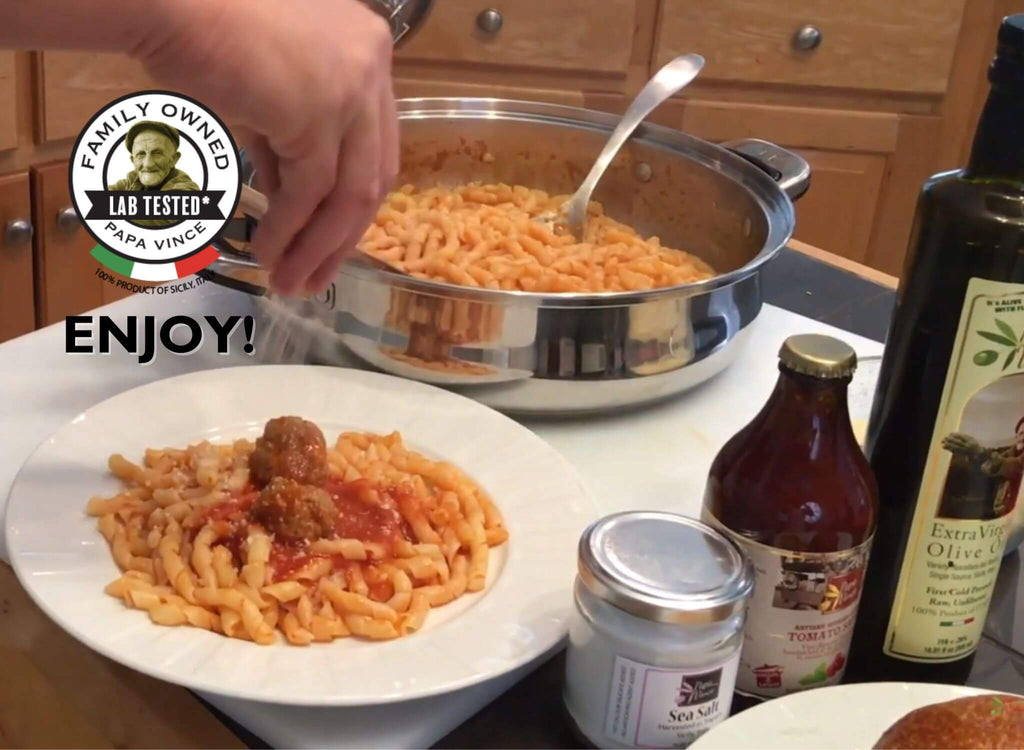
Disclaimer: These statements have not been evaluated by the Food and Drug Administration...
Sources
1. Dietary Reference Intakes: Guiding Principles for Nutrition Labeling and Fortification.
Institute of Medicine (US) Committee on Use of Dietary Reference Intakes in Nutrition Labeling. Washington (DC): National Academies Press (US); 2003.
Date accessed: December 12, 2023
Read full article on the National Library of Medicine
2. Folate and Folic Acid on the Nutrition and Supplement Facts Labels.
U.S. Food & Drug Administration. Content current as of September 27, 2023.
Date accessed: December 12, 2023
Read full article on FDA.gov
3. Dr. Jin Sung's video: Vitamin B9—Folate vs Folic Acid
Date accessed: December 12, 2023
4. Manufacturers Are Not Required to Label Pasta as "Enriched"
Various sources — Date accessed: December 12, 2023
-
CFR - Title 21: Food and Drugs - Part 139 - Macaroni and Noodle Products
– Enriched Macaroni
– Enriched Noodles -
FDA Guidance Document – Compliance Policy Guide Sec. 555.550
View Policy Guide -
FDA – Food Labeling & Nutrition
Visit FDA Nutrition Page -
FDA – Search Terms: "Enriched Pasta" or "Enrichment Ingredients"
Search FDA Food Database -
USDA – Grain Products
View MyPlate Grain Guide
5. Influence of Some Spaghetti Processing Variables on Technological Attributes and the In Vitro Digestion of Starch.
Sissons, M., Cutillo, S., Egan, N., Farahnaky, A., & Gadaleta, A. (2022). Foods (Basel, Switzerland), 11(22), 3650.
Date accessed: December 12, 2023
Also available via PubMed Central
